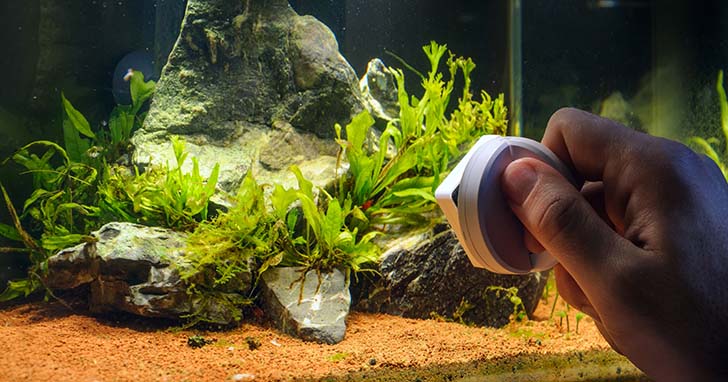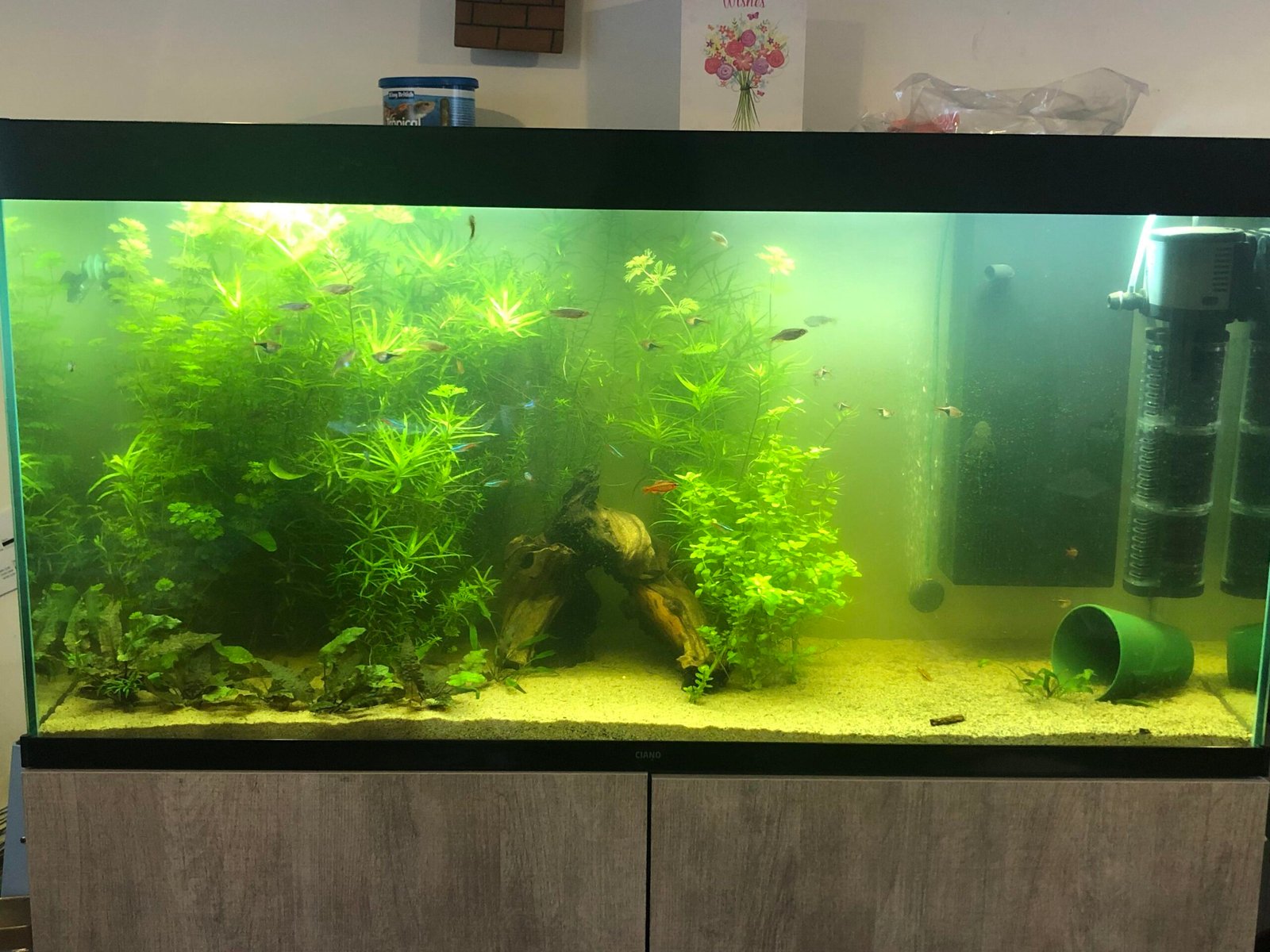Yes, aquarium plants can help reduce algae. They compete with algae for nutrients and light, creating a balanced ecosystem.
Aquarium enthusiasts often face the challenge of algae overgrowth. Algae can make tanks look dirty and harm fish. But there’s a natural solution: live plants. Adding plants to your aquarium not only enhances its beauty but also helps in controlling algae.
Plants absorb nutrients that algae need to grow, thus limiting algae’s food supply. They also shade the tank, reducing light availability for algae. This creates a healthier environment for your aquatic pets. In this blog, we will explore how aquarium plants can play a vital role in managing algae and maintaining a clean, balanced aquarium. Stay tuned to discover the benefits and best plant choices.
Introduction To Aquarium Plants And Algae
Many aquarium enthusiasts often wonder if aquarium plants can help in reducing algae. The answer is yes. Aquarium plants play a crucial role in maintaining the health of your tank. They provide numerous benefits and contribute to a balanced ecosystem.
Aquarium Plant Benefits
Aquarium plants offer several advantages:
- Oxygen Production: Plants produce oxygen which is essential for fish and other aquatic life.
- Natural Filtration: Plants absorb harmful chemicals and waste, keeping the water clean.
- Algae Reduction: Plants compete with algae for nutrients, thus limiting algae growth.
Common Types Of Algae
Understanding the types of algae in your aquarium is important:
| Type of Algae | Description |
|---|---|
| Green Algae | Common in healthy tanks. Appears as green spots or film. |
| Brown Algae | Often found in new tanks. Looks like brown dust on surfaces. |
| Blue-Green Algae | Actually cyanobacteria. Forms slimy layers and can be toxic. |
| Hair Algae | Looks like green hair or threads. Difficult to remove. |
Each type of algae has different causes and solutions. Identifying them helps in choosing the right approach to control algae growth.

Credit: www.youtube.com
Mechanism Of Algae Reduction
Aquarium plants can play a crucial role in reducing algae. They use various mechanisms to outcompete algae for resources. This can lead to a healthier, more visually appealing aquarium. Let’s explore how these mechanisms work.
Nutrient Competition
Plants and algae both need nutrients to grow. These include nitrogen, phosphorus, and potassium. Aquarium plants absorb these nutrients from the water. This leaves less available for algae. When plants take up more nutrients, algae find it harder to thrive.
Consider the following table showing nutrient uptake:
| Element | Plants | Algae |
|---|---|---|
| Nitrogen | High | Moderate |
| Phosphorus | High | Low |
| Potassium | High | Low |
From the table, it’s clear that plants absorb more nutrients. This limits what algae can use. As a result, algae growth slows down.
Light Absorption
Both plants and algae need light for photosynthesis. Aquarium plants, especially tall ones, can shade algae. This reduces the amount of light algae receive. Less light means less energy for algae to grow.
Here are some effective plants for light absorption:
- Amazon Sword
- Anubias
- Java Fern
- Hornwort
These plants have broad leaves. They can cover large areas, blocking light from reaching algae below. With less light, algae cannot photosynthesize efficiently. This leads to a reduction in algae growth.
Types Of Aquarium Plants
When setting up an aquarium, choosing the right plants is essential. Some plants can help reduce algae, making tank maintenance easier. Here, we will explore the different types of aquarium plants that can aid in controlling algae growth.
Fast-growing Plants
Fast-growing plants are excellent for reducing algae. They absorb nutrients quickly, leaving less for algae to thrive on. Here are a few examples:
- Hornwort: This plant grows rapidly and can float or be anchored.
- Water Wisteria: It grows fast and provides excellent cover for fish.
- Anacharis: Known for its speed, it effectively competes with algae for nutrients.
Floating Plants
Floating plants are another great option. They block light from reaching algae, thus limiting its growth. Some popular floating plants include:
- Duckweed: Small but effective, it forms a dense cover on the water surface.
- Amazon Frogbit: Larger than duckweed, it also provides shade and reduces algae.
- Water Lettuce: This plant has rosette leaves that float, offering shade and nutrient absorption.
Choosing the right plants not only enhances the beauty of your tank but also helps in maintaining a healthy environment for your fish. Select a mix of fast-growing and floating plants to keep algae under control.
Best Plants For Algae Control
Algae can be a persistent problem in aquariums. Many hobbyists are searching for effective ways to control its growth. One natural and efficient method is to introduce live plants into your tank. Certain aquarium plants are particularly good at reducing algae by competing for nutrients and light. Here are some of the best plants for algae control:
Java Moss
Java Moss is a popular choice for many aquarium enthusiasts. It grows easily and adapts to various water conditions. Java Moss absorbs excess nutrients, which helps in reducing algae growth.
This plant can be attached to rocks, driftwood, or other decorations. It provides a natural habitat for fish and shrimps. Java Moss is also low maintenance and doesn’t require special lighting or CO2 injection.
Anubias
Anubias is another great plant for controlling algae. It is hardy and can thrive in low light conditions. Anubias grows slowly, making it ideal for tanks with minimal maintenance.
This plant can be planted in the substrate or attached to decorations. Anubias leaves are broad, giving a lot of surface area for beneficial bacteria to grow. This helps in maintaining good water quality and reducing algae.
| Plant | Light Requirement | Growth Rate | Maintenance Level |
|---|---|---|---|
| Java Moss | Low to Moderate | Fast | Low |
| Anubias | Low | Slow | Low |
Incorporating Java Moss and Anubias into your aquarium can significantly help in controlling algae. They are easy to care for and contribute to a balanced ecosystem.
Plant Care And Maintenance
Maintaining healthy aquarium plants can be challenging. But it’s worth the effort. Proper care and maintenance can reduce algae growth and keep your tank beautiful. Let’s explore the key aspects of plant care and maintenance.
Water Quality
Water quality is crucial for healthy plants. Ensure your tank’s water is clean and well-balanced. Regular water changes help maintain optimal conditions. Use a water testing kit to check pH, ammonia, nitrate, and nitrite levels. Consistent monitoring prevents algae growth and keeps plants healthy.
Pruning Techniques
Pruning is essential for plant health. Trim dead or dying leaves regularly. This prevents decay, which can promote algae growth. Cut back overgrown plants to allow light to reach all areas. Use sharp scissors to make clean cuts. Pruning stimulates new growth and keeps plants vibrant.
Balancing Plant And Fish Needs
Keeping a harmonious aquarium involves balancing the needs of both plants and fish. Algae can be a common problem in tanks. The right plants can help control algae growth. But it’s essential to maintain a balance. Both plants and fish must thrive together.
Optimal Plant Density
Choosing the right number of plants is crucial. Too few plants, and algae will take over. Too many, and your fish may not have enough space. Aim for a moderate plant density. This ensures enough plants to absorb excess nutrients. But also leaves ample swimming room for fish.
| Tank Size | Optimal Plant Density |
|---|---|
| Small (10-20 gallons) | 5-10 plants |
| Medium (20-50 gallons) | 10-20 plants |
| Large (50+ gallons) | 20-30 plants |
Monitor the plant growth. Ensure they do not overcrowd the tank. Regular trimming helps maintain balance. Healthy plants mean less algae. This creates a better environment for your fish.
Fish-friendly Plants
Not all plants are ideal for every fish. Some fish may nibble on plants. Others may require specific plant types. Choosing the right plants ensures both plants and fish can coexist.
- Anubias: Hardy and low maintenance. Suitable for most fish.
- Java Fern: Great for beginner aquariums. Fish usually leave it alone.
- Amazon Sword: Ideal for larger tanks. Provides good hiding spots for fish.
- Hornwort: Fast-growing. Absorbs nutrients quickly, reducing algae.
Consider the needs of your fish species. Some fish prefer plants they can hide in. Others like open swimming spaces. Research your fish’s natural habitat. This helps in selecting the best plants.
Balance is key. A well-planted tank reduces algae. It also creates a healthier environment for fish. Happy fish and thriving plants make for a beautiful aquarium.
Alternative Algae Control Methods
Algae growth in aquariums can be a persistent problem for many aquarium enthusiasts. While aquarium plants can help reduce algae by competing for nutrients, there are other methods to control algae as well. Here, we will explore some alternative algae control methods that you can consider.
Chemical Treatments
Chemical treatments are a popular choice for controlling algae. These treatments often come in liquid or tablet forms. They work by killing algae on contact. It’s important to follow the instructions carefully to avoid harming your fish or plants.
Common chemical treatments include:
- Algaecides
- Hydrogen peroxide
- Potassium permanganate
Using chemicals can be effective, but it’s essential to monitor water quality regularly. Overuse can lead to an imbalance in the aquarium’s ecosystem.
Algae-eating Fish
Adding algae-eating fish to your aquarium is a natural way to control algae. These fish feed on algae, helping to keep it under control. Below is a table with some common algae-eating fish:
| Fish | Type of Algae |
|---|---|
| Siamese Algae Eater | Hair algae |
| Otocinclus Catfish | Brown algae |
| Chinese Algae Eater | Green algae |
These fish can be a valuable addition to your tank. They help control algae while adding diversity to your aquarium community. Make sure the fish you choose are compatible with your existing fish and plants.

Credit: www.liveaquaria.com
Conclusion And Final Thoughts
Aquarium plants play a significant role in reducing algae. They compete with algae for nutrients and light. This makes the tank healthier and more enjoyable. Algae can be a persistent problem for many aquarium enthusiasts. But with the right plants, you can keep it in check.
Long-term Benefits
Using live plants has long-term benefits for your aquarium. They maintain balance in the tank. They help in oxygenating the water. This benefits both fish and other aquatic life. Healthy plants also absorb harmful toxins. They keep the water clean and safe. Over time, plants create a stable environment. This reduces the chance of algae taking over.
Personal Experiences
Many aquarium owners have shared their experiences. They find that plants make a big difference. One hobbyist noted fewer algae issues after adding more plants. Another mentioned clearer water and happier fish. These personal stories highlight the positive impact of aquarium plants. They show that plants can be a natural solution to algae problems.

Credit: buceplant.com
Frequently Asked Questions
How Do Aquarium Plants Help Reduce Algae?
Aquarium plants absorb nutrients that algae need to grow. This reduces algae growth by competing for resources.
Which Plants Are Best For Controlling Algae?
Fast-growing plants like Hornwort and Water Wisteria are effective. They outcompete algae for nutrients.
Do Aquarium Plants Improve Water Quality?
Yes, aquarium plants improve water quality by absorbing toxins and releasing oxygen.
Can Live Plants Prevent Algae Blooms?
Live plants can help prevent algae blooms by maintaining a balanced ecosystem and reducing excess nutrients.
Conclusion
Aquarium plants can indeed help reduce algae. They compete for nutrients, starving algae. Plants also produce oxygen, improving water quality. Healthy plant growth limits algae’s space to thrive. Choose the right plants for your tank. Regular maintenance remains essential. Clean your aquarium and monitor plant health.
Combining plants with good practices keeps algae in check. Enjoy a cleaner, more beautiful tank.





